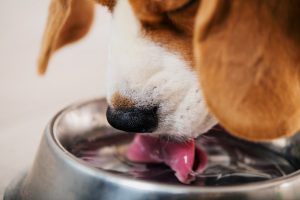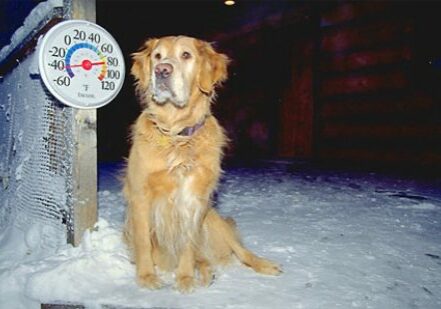Weather Safety Tips
Extreme Heat

NEVER leave your pet unattended in the car. Your car is like an oven, even with the windows cracked. On a 78-degree day, your car can heat up to over 90 degrees when parked in the shade. Imagine how hot it can get when parked in the sun! Leave them at home or in a safe cool place.
Keep hydrated. Provide plenty of fresh, cool water. Check the water throughout the day to make sure it is cool enough to drink and make sure to keep it out of direct sunlight.
Need shade or cool area, if outdoors. Pets can’t sweat like humans so they need a proper place to escape if they get too hot. Be sure that there is a shade tree or a spot to lay under when outside (remember the sun moves so they must have shade during all times of the day) or a cool place in the house to retreat.

Avoid hot asphalt. In some areas, asphalt can get hot enough to fry an egg– imagine how that must feel on your pet’s paw pads! Try to only walk during the early morning or late evening and stick to grass and gravel trails rather than asphalt. Standing still on hot asphalt can cause burns to their paw pads.
Know symptoms of overheated pet. Symptoms of an overheated pet include difficulty breathing, excessive panting, drooling, in creased heart rate, weakness and even collapse. Contact a veterinarian immediately if your pet becomes overheated.
Exercise early morning or late evening. Exercising in the summer heat can be just as uncomfortable for your pet as it is for you. Take your walks in the early mornings or late evening, not in the midday heat. They will need to cool down, just like you do, if exercised.
Flat-faced furry friends need extra care. Brachycephalic animals such as Pugs, French Bulldogs, and Persian cats cannot pant and cool down as effectively as our longer-muzzled pets. Here in the Central Valley, we lose pets every summer due to overheating.
Pets In Unattended Vehicles

WHEN CAN YOU BREAK A WINDOW TO SAVE PET IN A HOT CAR IN CALIFORNIA?
In hot temperatures, animals can quickly die if left in a vehicle without adequate ventilation. If you see a pet in a locked hot car, before attempting to remove it, call 911 FIRST! Also, if pet is removed by you - do not leave the scene with the pet. At the end of this post, there are also some first-aid tips.
Here is an an excerpt from the State of California Penal Code - Section 597.7. regarding removing pets from vehicles. For the full read, visit: CA Laws On Leaving Pets Unattended In Cars If you have any more questions, please contact your local animal control agency.
597.7. (a) A person shall not leave or confine an animal in any unattended motor vehicle under conditions that endanger the health or well-being of an animal due to heat, cold, lack of adequate ventilation, or lack of food or water, or other circumstances that could reasonably be expected to cause suffering, disability, or death to the animal.
(b) (1) This section does not prevent a person from taking reasonable steps that are necessary to remove an animal from a motor vehicle if the person holds a reasonable belief that the animal’s safety is in immediate danger from heat, cold, lack of adequate ventilation, lack of food or water, or other circumstances that could reasonably be expected to cause suffering, disability, or death to the animal.
(2) A person who removes an animal from a vehicle in accordance with paragraph (1) is not criminally liable for actions taken reasonably and in good faith if the person does all of the following:
(A) Determines the vehicle is locked or there is otherwise no reasonable manner for the animal to be removed from the vehicle.
(B) Has a good faith belief that forcible entry into the vehicle is necessary because the animal is in imminent danger of suffering harm if it is not immediately removed from the vehicle, and, based upon the circumstances known to the person at the time, the belief is a reasonable one.
(C) Has contacted a local law enforcement agency, the fire department, animal control, or the “911” emergency service prior to forcibly entering the vehicle.
(D) Remains with the animal in a safe location, out of the elements but reasonably close to the vehicle, until a peace officer, humane officer, animal control officer, or another emergency responder arrives.
(E) Used no more force to enter the vehicle and remove the animal from the vehicle than was necessary under the circumstances.
(F) Immediately turns the animal over to a representative from law enforcement, animal control, or another emergency responder who responds to the scene.
First-Aid Tips:
In the event you remove an animal from a hot vehicle, and you believe the animal is suffering from a heat related illness, do the following:- Remove from direct sunlight
- Place the animal on a cool surface
- Direct a fan (if available) towards the animal
- Place wet towels on the back and under the armpits of pet
- The owner should get the pet to an animal hospital
DON'T: Use cold water or ice, over cool the animal, and don't force the animal to drink
Cold Weather

The Central California Animal Disaster Team offers these important tips to keep your pets healthy, safe and well during the winter weather and if you travel in areas where there is snow.
Keep your pets inside -when possible when freezing weather occurs. If you have to take them out, stay outside with them. If it is too cold for you, it is too cold for them.
If you absolutely must leave them outside –for a significant amount of time, make sure they have a warm, solid shelter against the wind, thick dry bedding, and plenty of non-frozen water.
Never leave your dog or cat - alone in a car during cold weather. A car can act as a refrigerator in the winter, holding in the cold and causing the animal to freeze to death.
During the winter - outdoor cats sometimes sleep under the hoods of cars. When the motor is started, the cat can be injured or killed by the fan belt. Please remember to bang loudly on the car hood before starting the engine to give the cat a chance to escape.
Thoroughly wipe off - your dog's legs and stomach when he comes in out of the sleet, snow or ice. He can ingest salt, antifreeze or other potentially dangerous chemicals while licking his paws, and his paw pads may also bleed from snow or encrusted ice.
If you light a fire or plug in a space heater –to keep your home warm, remember that the heat will attract your pets as well. If they snuggle up to the warmth, keep an eye out to make sure that no paws or tails come in contact with flames, heating coils, or hot surfaces. Pets can either burn themselves or knock a heat source over and put the entire household in danger.
Never let your dog off leash - on snow or ice, especially during a snowstorm, dogs can lose their scent and easily become lost. More dogs are lost during the winter than during any other season, so make sure yours always wears ID tags.
Pets lose most of their body heat –from the pads of their feet, their ears, and their respiratory tract. You can put them in a sweater when they are with you, however the best way to guard your animal against the cold is by keeping a close eye on them. Make sure they are comfortable, when outside with them, watch for signs of discomfort from the cold.
